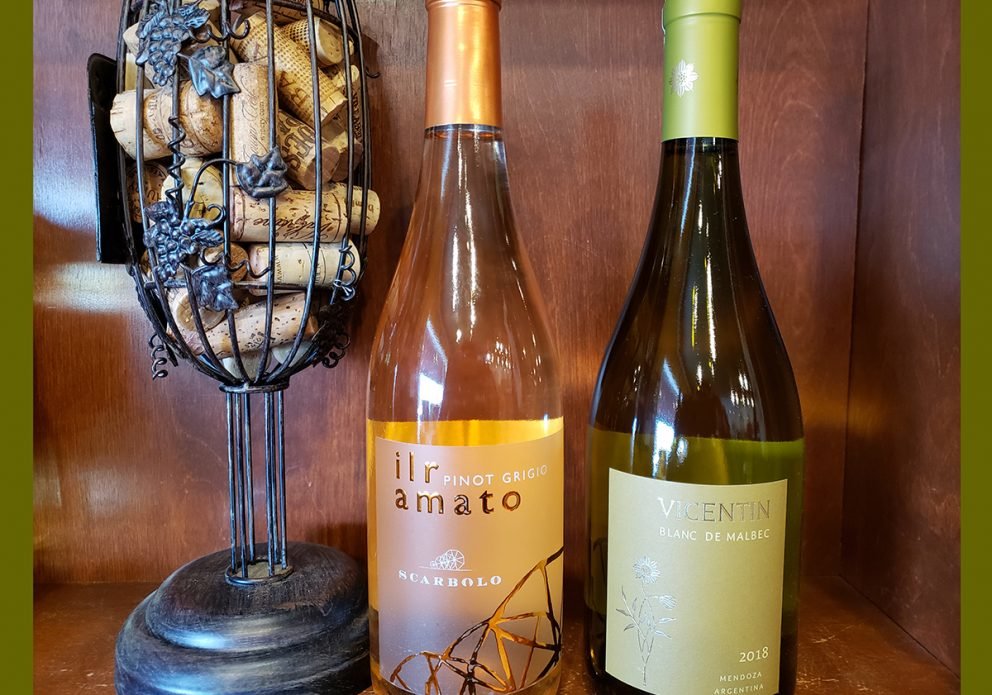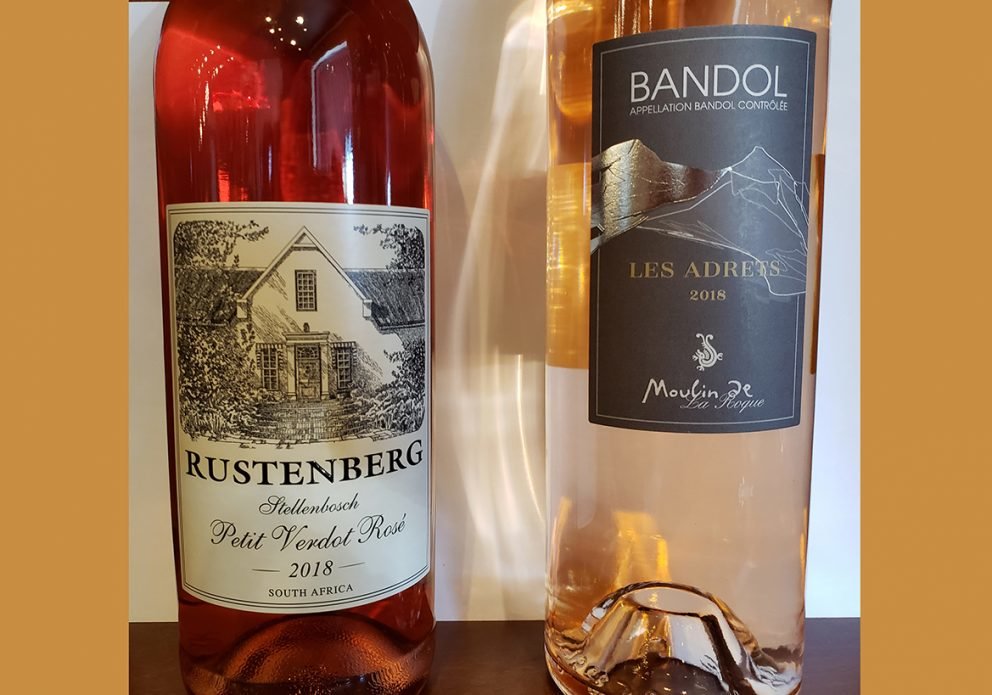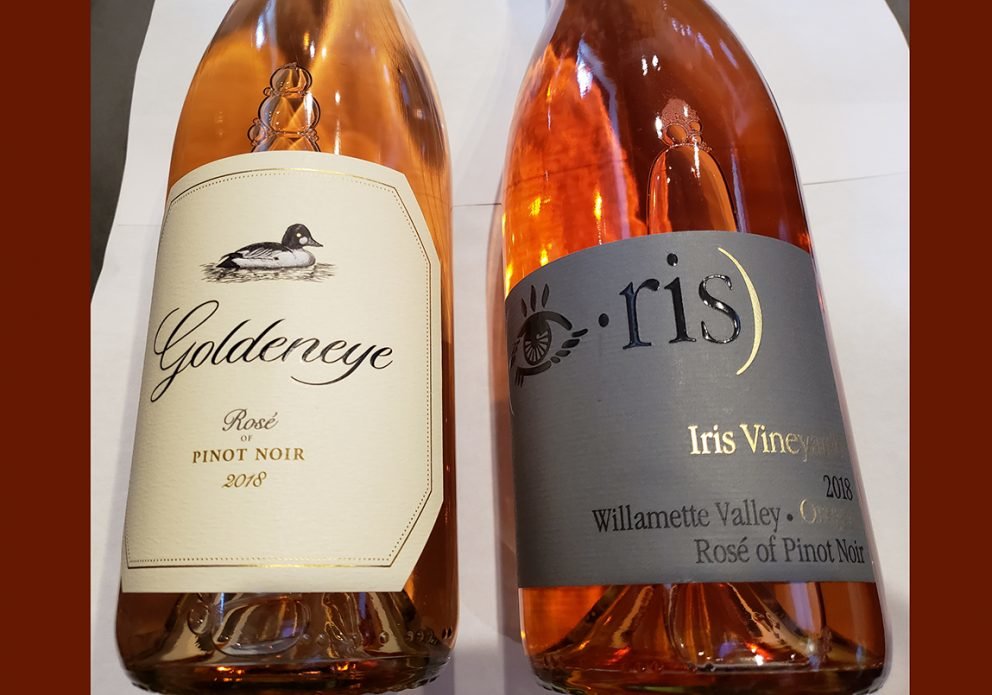This popular idiom is often used to imply that you are vested in the outcome of a situation. Well, when it comes to making wine, this phrase can be taken literally. Because the pigmentation of wines comes from the skins of grapes, the resulting color of the wine depends on how much skin contacts the juice.
White wines are usually produced from light, green-skinned grapes. Reds, on the other hand, are created from dark, black-skinned grapes. The actual juice of most grape varietals is colorless. Therefore, it is entirely possible to make a pink or even pale white colored wine from a black skinned grape simply by separating the skins from the juice immediately after picking, but prior to fermentation.
Pictured are two of the hottest trends in wine: a white Malbec and orange Pinot Grigio. (More on the orange Pinot Grigio later.) We tasted these wines recently and found them to be so deliciously unique that we had to bring them into our shop. Our customers also love the Left Coast White Pinot Noir, which we have carried for about five years now. You’ll note the Schug Pinot Noir is a red wine, made from the same grape varietal. White Merlot is gaining popularity as well, because winemakers are constantly pushing the limits with their experimentation. It’s not just good marketing; wine consumers are hungry to try something new as well.
Did you know that the finest, clear colored sparkling wines come from Champagne, France, most of which are made from the black-skinned Pinot Noir grape in combination with the green skinned Chardonnay grape? Logically, to make a pink Champagne or sparkling wine, you leave the skins in the must for a bit – or a lot – depending on how deep you want the pink color to be. (Must is the freshly crushed grape juice that contains the skins, seeds, and stems.) Likewise, to make a Rosé wine, the juice of black grapes is allowed a brief period of contact with the skins. See the side-by-side comparison of the Rustenberg Rosé of Petite Verdot (from South Africa) versus the Bandol Rosé of Cinsault and Mourvedré (from Provence, France).
Grape skins’ thickness also has a lot to do with the color of the wine, given the same amount of time with the juice. The thicker the skin, usually the richer the color. The darkest, richest and fullest red wines are made from deeply pigmented, thick-skinned grapes such as Cabernet Sauvignon, Merlot, Syrah and Petite Sirah. Pinot Noir, on the other hand, is characteristically thinner skinned, and thus, ending up as lighter colored with a softer tannin, creating more delicate styles of red wines than Cabernet Sauvignon, Merlot or Syrah. Likewise, Cinsault and Grenache grapes are thinner skinned.
Grape skins contain the bitter or astringent taste of tannin, the phenolic component that is also found in the seeds and stems. Tannin can enhance a red wine, but white wines are not so palatable when they have the bitter taste of tannin. You want white wines to taste smooth and fresh, not hard or astringent. Same for Rosés. The orange Pinot Grigio was made from ripened grapes that have dark skin that is macerated briefly at the start of fermentation and is considered a “vin gris” style of Rosé, or an “orange” wine. The substantial flavors are perfect for the fall season with flavors to complement many foods that will be arriving on your table.
Customers often ask why some Rosés are pale pink colored, some salmon pink, and some more cherry colored. The answer is, “It depends on the grape varietal.” The Hendry Rosé is made from Zinfandel, Cabernet and Primitivo grapes. It’s much darker pink than the Chateau Beaulieu Rosé, which is made with typical Provence grapes: Grenache, Cinsault, Syrah. Depending on what result the winemaker wants in the flavor and texture of the end product, even Rosés made from the same grape can be different in color. (See Goldeneye vs. Iris, both Rosé of Pinot Noir.)
While not as delicate as Pinot Noir, skins of the Zinfandel grape are actually fairly thin in comparison to the thicker-skinned varieties. However, one of the characteristics of Zinfandel is that it grows and ripens uneven sized berries – “hens and chicks,” as growers often describe them. Therefore, with many of the smaller berries in typical Zinfandel clusters having higher skin-to-juice ratios, Zinfandels usually end up as red wines that are quite dark – vivid purplish rubies – and also sturdy in tannin, plus lots of fruitfulness, since most of every wine’s flavor, directly related to aromatic qualities, is also derived from compounds originating in the skins.
Thankfully, the wine industry has come a long way since the 1970s. And consumers are more sophisticated in their evolving palates to the point where most people I know now understand the difference between a white Zinfandel (mass produced, sweet and one dimensional) and a true Rosé wine (dry and nuanced layers of fruit, herbs and texture). My friend Sue of 35 years still orders a white Zinfandel in a restaurant, despite my protest and attempt to educate. But hey, at Teller Wines, our mantra is “a good wine is one you like.” So, who am I to judge?
What you can judge is the color of the wine and choose your taste preference based on it. If you like a bigger, rounder mouthfeel in a Rosé, go for the Rustenberg or Hendry. If you prefer a lighter style with subtle fruit flavors and herbal, minerally finish, go for a Provence Rosé, or the Goldeneye (made by Duckhorn Vineyards).
Here’s a tip the pros use: Next time you taste a wine, hold the glass up against a white surface like a napkin, tablecloth, tasting sheet, etc. That’s the only way you can see the true color of a wine. Skins and all!


































